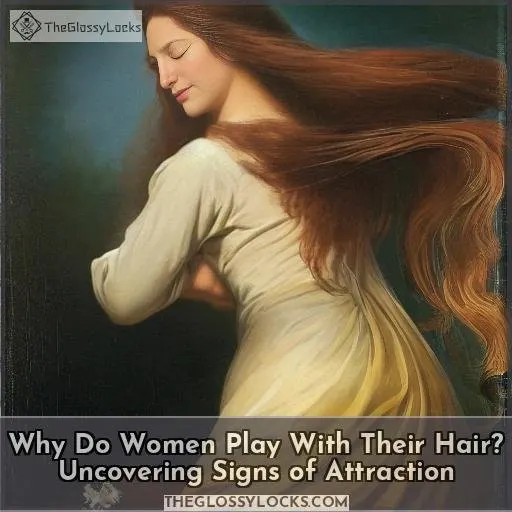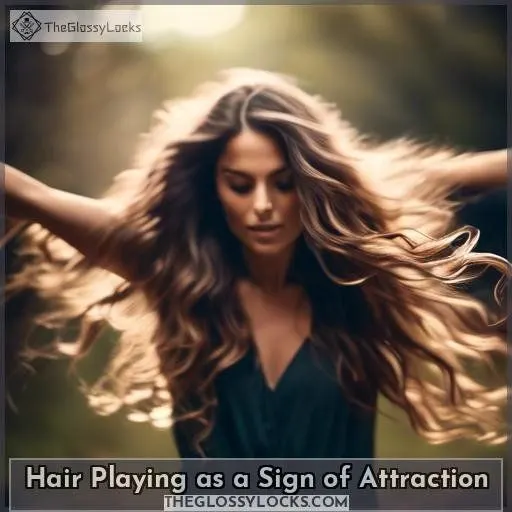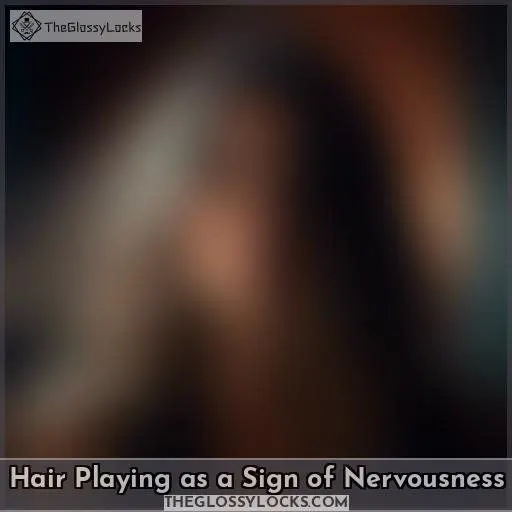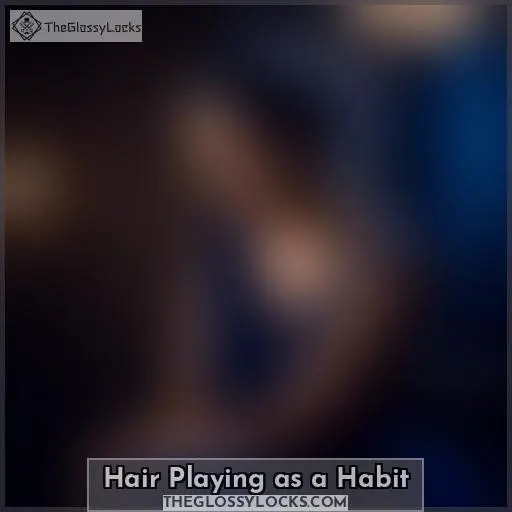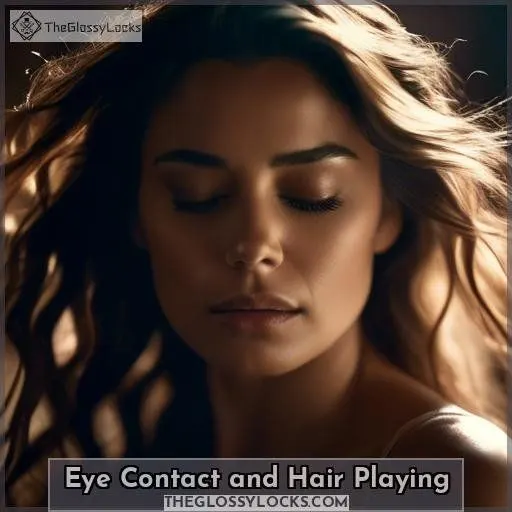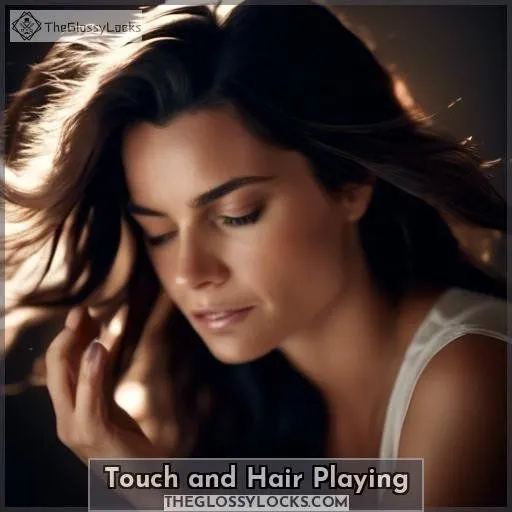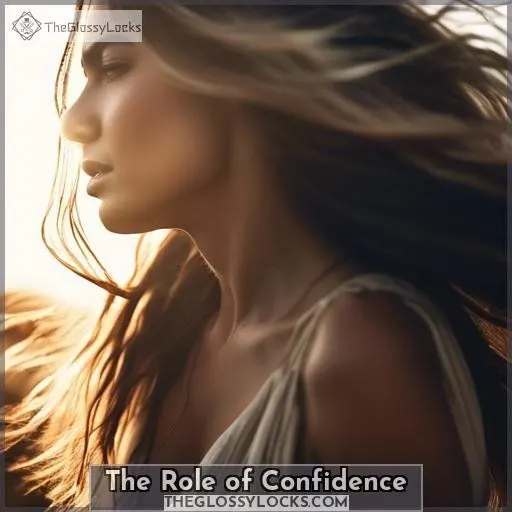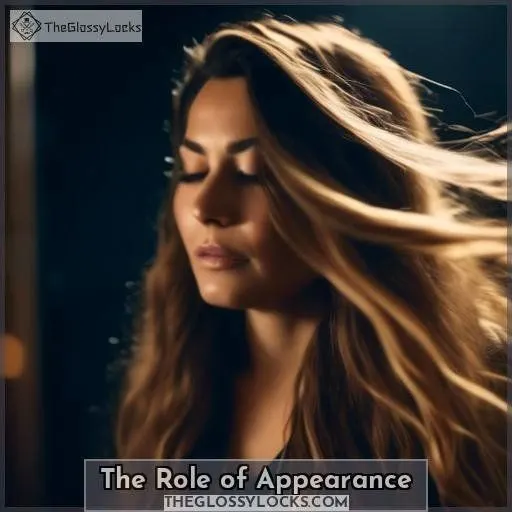This site is supported by our readers. We may earn a commission, at no cost to you, if you purchase through links.
You’ve noticed women playing with their hair and wondered why. This subconscious behavior often signifies attraction – she’s releasing tension, boosting confidence, and drawing your attention to indicate interest.
However, it can also stem from nervousness, insecurity, or simply habit.
Hair twirling coupled with prolonged eye contact suggests flirtation, while avoiding your gaze likely means nervousness.
Context matters – touch, body language, and setting provide cues on her feelings and intentions behind playing with her hair.
Uncovering these nonverbal nuances reveals deeper insights into whether it’s attraction or nerves prompting the hair play.
Table Of Contents
- Key Takeaways
- Why Do Women Play With Their Hair?
- Hair Playing as a Sign of Attraction
- Hair Playing as a Sign of Nervousness
- Hair Playing as a Habit
- Eye Contact and Hair Playing
- Touch and Hair Playing
- Interpreting Other Signs of Attraction
- The Role of Confidence
- The Role of Appearance
- The Cultural Significance of Hair Play
- Frequently Asked Questions (FAQs)
- Conclusion
Key Takeaways
- Women play with their hair as a sign of attraction, releasing tension, boosting confidence, and drawing attention to indicate interest.
- Hair twirling coupled with prolonged eye contact suggests flirtation, while avoiding eye contact likely means nervousness.
- Hair playing can also be a nervous habit or a way to cope with boredom, anxiety, or stress.
- Understanding the context, including tone, body language, and setting, is crucial for interpreting the meaning behind hair play.
Why Do Women Play With Their Hair?
Women play with their hair for various reasons, including attraction, nervousness, habit, and confidence-boosting. In some cases, hair playing can be an unconscious redirection of attention or a sign of flirting.
In other cases, it might indicate nervousness or a nervous habit. Cultural background, ethnicity, and regional influences can also impact the interpretation of hair playing. It’s important to take into account the context and the individual’s behavior to accurately decipher the true intent behind this behavior.
Hair Playing as a Sign of Attraction
When a woman plays with her hair, it can be a sign that she’s attracted to you. Hair play is a subconscious behavior that women do when they’re nervous or excited. It’s a way for them to release tension and feel more confident. When a woman plays with her hair, she’s trying to draw your attention to her and show you that she’s interested in you. If you find a woman attractive and she starts playing with her hair when she meets you, it’s a strong sign that she likes you too.
Hair playing can also be influenced by her hair color, length, texture, and accessories. For example, blonde hair may attract attention because it’s seen as new and exciting due to its rarity. Brunette hair has been associated with intelligence, independence, and competence, which may make women with brunette hair more attractive.
Eye contact and hair playing can also be important indicators of attraction. Prolonged eye contact indicates interest, and mutual eye contact is a good sign. Avoiding eye contact may indicate nervousness. Light touching while talking may indicate interest, and touching in a formal setting may be a nervous habit. Teasing or giving awkward compliments may be flirting.
Hair Playing as a Sign of Nervousness
When you notice a woman playing with her hair, it can be a sign of nervousness.
She may be twirling her hair around her finger, playing with the ends, pulling it out, or exhibiting nervous tics. These behaviors can be indicative of insecurity, boredom, or a habitual nervous response.
She may be attempting to distract herself from the situation or as a self-soothing tactic.
In some cases, these behaviors can be a symptom of trichotillomania, a disorder characterized by an irresistible urge to pull hair out of the scalp, eyebrows, eyelashes, and other parts of the body.
If you observe a woman playing with her hair excessively, it’s important to bear in mind the context and other signs of nervousness to determine if it’s a sign of attraction or just a habitual behavior.
Hair Playing as a Habit
Playing with your hair can be a habit, a coping mechanism for boredom, anxiety, or stress, or a way to feel more confident or attractive. It can be a nonverbal way to communicate interest, nervousness, or personal boundaries. Understanding the context and your own feelings can help you interpret the meaning behind this behavior.
Eye Contact and Hair Playing
Shifting gears from the habitual twirls of hair play, let’s explore the silent conversation of glances. When someone intertwines hair playing with eye contact, it’s like a dance of the eyes, hinting at a deeper connection. Prolonged eye contact paired with a playful hair flip can be a siren’s call of attraction, while mutual gazes weave a silent bond of intimacy. But beware, avoiding eye contact might signal nerves in a formal setting. A well-timed compliment can turn a simple flirt into a magnetic moment.
- Prolonged eye contact and hair twirling: A flirtatious duo signaling interest.
- Mutual eye contact: Silent whispers of a budding connection.
- Avoiding eye contact: A bashful retreat that may speak of nervousness.
- Hair playing in a formal setting: A nervous habit or a subtle invitation?
- Complimenting the mane: A charming way to acknowledge the flirt and strengthen the bond.
Touch and Hair Playing
Touch and hair playing can be interpreted in various ways, depending on the context and the individuals involved. Here are some possible interpretations:
- Subtly courting: Light touching while talking may indicate interest or attraction. This can be a way to establish a physical connection without being too overt.
- Nervous habit: Touching in a formal setting may be a nervous habit, indicating discomfort or anxiety. This could be a sign that the person isn’t fully comfortable in the situation.
- Flirtatious gesture: Playing with clothing or jewelry can be a sign of nervousness or a flirtatious gesture. This could be a way to draw attention to oneself or to signal interest in someone else.
- Flirtatious interaction: Fidgeting can indicate nervousness or anxiety, but it can also be a sign of flirtatiousness. This could be a way to engage in playful banter or to create a sense of intimacy.
To interpret these signs accurately, it’s vital to think about the context and the individuals involved. Paying attention to nonverbal cues, such as eye contact and body language, can also provide valuable insights into someone’s feelings and intentions.
Interpreting Other Signs of Attraction
Regarding the interpretation of other signs of attraction, it’s crucial to bear in mind that each individual is distinct, and their preferences and behaviors can differ greatly. However, some general patterns can assist you in comprehending the underlying motivations behind hair playing and other nonverbal cues.
Firstly, hair length, color, and style can all play a role in attraction. For example, a man with long hair may be perceived as more creative, rebellious, or open-minded, which can be attractive to some women. Similarly, a woman with healthy, well-kept hair is often seen as responsible, classy, and attentive, which can be a turn-on for men.
Hair health is also a significant factor in attraction. A healthy scalp is the key to stronger, smoother, and fuller-looking hair. This means that a woman who takes care of her scalp and hair is likely to be seen as someone who takes care of herself and her appearance, which can be a sign of attractiveness and self-confidence.
Hair accessories can also be a sign of attraction. For example, a woman who wears a hairband or clip may be subconsciously signaling that she’s open to being touched or approached. Similarly, a man who runs his fingers through his hair may be trying to convey a sense of confidence and masculinity, which can be attractive to women.
When interpreting other signs of attraction, it’s crucial to bear in mind that mutual understanding and respect are key. Avoid making assumptions or jumping to conclusions based on a single behavior or cue. Instead, try to engage in conversation and respond playfully**, which can help you build a deeper connection and better understand each other’s intentions.
The Role of Confidence
Playing with your hair is a complex behavior that can reveal a range of emotions, from attraction to nervousness and habit.
It’s crucial to consider the context in which hair playing occurs to accurately interpret its meaning.
Confidence plays a significant role in hair playing, as it can be a way to boost self-esteem and attractiveness.
Women may play with their hair to convey confidence, draw attention to their well-groomed locks, or even to manipulate social signals.
Hair can be a powerful tool for self-expression and can impact how others perceive us.
By understanding the role of confidence in hair playing, we can better navigate social situations and communicate effectively.
The Role of Appearance
The role of appearance in hair playing is significant.
Women often play with their hair as a way to enhance their beauty and fit into societal beauty standards.
They may do this to feel more confident or attractive.
Hair is a powerful symbol of femininity and allure.
Additionally, cultural norms and societal expectations can influence how women perceive their hair and its role in their overall appearance.
By understanding the role of appearance in hair playing, we can gain a deeper insight into why women engage in this behavior.
We can also gain insight into how it relates to their feelings of attraction and confidence.
The Cultural Significance of Hair Play
Hair has been a significant part of human culture for centuries, holding various meanings across different societies.
In some cultures, long hair is associated with femininity and beauty.
In others, it symbolizes power and status.
Hair play can be interpreted as a reflection of cultural norms and values.
In some cultures, playing with hair can be seen as a sign of attraction.
In others, it may be a nervous habit.
Understanding these cultural nuances can help better interpret the meaning behind hair play and the attraction it may represent.
Frequently Asked Questions (FAQs)
What are the underlying reasons for hair playing?
The core reasons? Flirting, boosting confidence, relieving nerves. Hair play is her subtle siren song – enticing yet inscrutable. Suss it out, Casanova; opportunity awaits those who can decipher the subtext.
How does hair playing affect self-confidence?
Hair playing boosts confidence – you’re subconsciously showcasing your attractive qualities. It’s a magnetic maneuver, radiating self-assuredness and enthralling admirers with stylish flair.
What are the cultural interpretations of hair playing?
Hair playing’s cultural meanings vary widely. It could signal flirtation, nerves, or habits. But don’t assume; observe eye contact, body language too for clearer cues.
How does hair playing differ between genders?
Like a flickering flame, hair play differs between genders – women use it to subtly flirt, while men do it unconsciously when anxious or focused.
What are the potential negative effects of hair playing?
You could damage your hair by playing with it too much. Constant pulling and twisting can lead to breakage, split ends, and even hair loss over time. Moderation is key – find other ways to channel your nervous energy or flirtatious vibes.
Conclusion
Imagine her fingers running through those silky strands, twirling a lock around her finger. You’ve uncovered why women play with their hair – a nonverbal cue revealing attraction, nerves or habit. By observing eye contact, touch, and context, you’ll decipher if it signifies flirtation or insecurity. Master reading these subtle signs to understand her deeper feelings behind the hair play.

